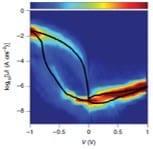To avoid crosstalk and suppress leakage currents in resistive random access memories (RRAMs), a resistive switch and a
current rectifier (diode) are usually combined in series in a one diode–one resistor (1D–1R) RRAM.

where multiple electronic functions are preprogrammed inside a single molecular layer with a thickness of only 2 nm.
References:
Yingmei Han, Cameron Nickle, Ziyu Zhang, Hippolyte P. A. G. Astier, Thorin J. Duffin, Dongchen Qi, Zhe Wang, Enrique del Barco, Damien Thompson and Christian A. Nijhuis
“Electric-field-driven dual-functional molecular switches in tunnel junctions”
Nature Materials 19, 843–848 (2020)
See more articles on this and similar topics.
Learn more on this general research topic.